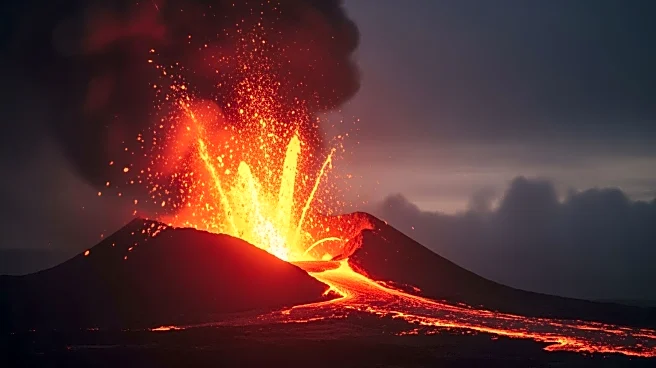What's Happening?
Indonesia's Mount Lewotobi Laki Laki erupted on Wednesday, spewing volcanic ash over 30,000 feet into the sky. The eruption led authorities to raise the alert level to its highest point, prompting the evacuation
of dozens of residents from nearby villages. The volcano, located in East Nusa Tenggara province, erupted twice on Wednesday, with the first eruption lasting around nine minutes and the second spewing ash over 26,000 feet high. Officials have warned of potential volcanic mudflows if heavy rain occurs, advising residents to clear a three- to four-mile area around the site. The eruption follows a major event in November 2024 that resulted in 10 fatalities and significant property damage.
Why It's Important?
The eruption of Mount Lewotobi Laki Laki is significant due to its potential impact on local communities and infrastructure. The evacuation of residents highlights the immediate threat to human safety, while the closure of Fransiskus Xaverius Seda airport underscores the disruption to transportation and economic activities in the region. Indonesia's position on the Pacific 'Ring of Fire' makes it prone to volcanic activity, affecting both domestic and international travel, as seen in previous eruptions that disrupted flights to Bali. The heightened alert level indicates ongoing risks, necessitating vigilance and preparedness from local authorities and residents.
What's Next?
Authorities are closely monitoring the volcano's activity and have advised residents to remain cautious of potential mudflows. The airport closure is expected to last until Thursday, affecting travel plans and logistics. Continued eruptions could lead to further evacuations and extended disruptions to air travel. Local disaster mitigation agencies are likely to remain on high alert, coordinating with geological experts to assess risks and implement safety measures. The situation may prompt discussions on improving volcanic monitoring systems and emergency response strategies in Indonesia.
Beyond the Headlines
The eruption raises questions about the long-term impact of volcanic activity on Indonesia's tourism industry, particularly in regions like Bali that are popular with international visitors. It also highlights the need for sustainable development practices in areas prone to natural disasters, balancing economic growth with environmental and safety considerations. The event may influence policy discussions on disaster preparedness and infrastructure resilience, emphasizing the importance of investing in technology and training to mitigate the effects of natural calamities.














